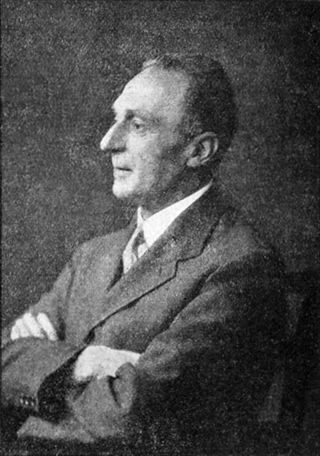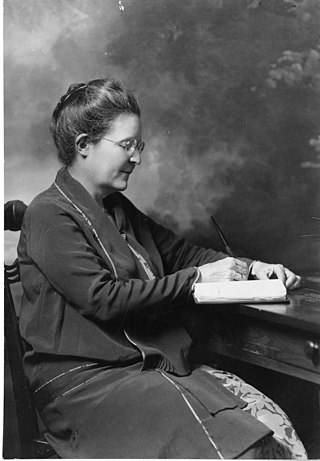Related Research Articles

Psychometrics is a field of study within psychology concerned with the theory and technique of measurement. Psychometrics generally refers to specialized fields within psychology and education devoted to testing, measurement, assessment, and related activities. Psychometrics is concerned with the objective measurement of latent constructs that cannot be directly observed. Examples of latent constructs include intelligence, introversion, mental disorders, and educational achievement. The levels of individuals on nonobservable latent variables are inferred through mathematical modeling based on what is observed from individuals' responses to items on tests and scales.

Personality psychology is a branch of psychology that examines personality and its variation among individuals. It aims to show how people are individually different due to psychological forces. Its areas of focus include:

Graphology is the analysis of handwriting with attempt to determine someone's personality traits. No scientific evidence exists to support graphology, and it is generally considered a pseudoscience or scientifically questionable practice. However, it remains in widespread use in France and has historically been considered legitimate for use in some court cases. The term is sometimes incorrectly used to refer to forensic document examination, due to the fact that aspects of the latter dealing with the examination of handwritten documents are occasionally referred to as graphanalysis.

In personality typology, the Myers–Briggs Type Indicator (MBTI) is an introspective self-report questionnaire indicating differing psychological preferences in how people perceive the world and make decisions. Despite its popularity, it has been widely regarded as pseudoscience by the scientific community. The test attempts to assign a value to each of four categories: introversion or extraversion, sensing or intuition, thinking or feeling, and judging or perceiving. One letter from each category is taken to produce a four-letter test result, such as "INTJ" or "ESFP".

Psychological testing is the administration of psychological tests. Psychological tests are administered by trained evaluators. A person's responses are evaluated according to carefully prescribed guidelines. Scores are thought to reflect individual or group differences in the construct the test purports to measure. The science behind psychological testing is psychometrics.

Psychology is an academic and applied discipline involving the scientific study of human mental functions and behavior. Occasionally, in addition or opposition to employing the scientific method, it also relies on symbolic interpretation and critical analysis, although these traditions have tended to be less pronounced than in other social sciences, such as sociology. Psychologists study phenomena such as perception, cognition, emotion, personality, behavior, and interpersonal relationships. Some, especially depth psychologists, also study the unconscious mind.

The Rorschach test is a projective psychological test in which subjects' perceptions of inkblots are recorded and then analyzed using psychological interpretation, complex algorithms, or both. Some psychologists use this test to examine a person's personality characteristics and emotional functioning. It has been employed to detect underlying thought disorder, especially in cases where patients are reluctant to describe their thinking processes openly. The test is named after its creator, Swiss psychologist Hermann Rorschach. The Rorschach can be thought of as a psychometric examination of pareidolia, the active pattern of perceiving objects, shapes, or scenery as meaningful things to the observer's experience, the most common being faces or other pattern of forms that are not present at the time of the observation. In the 1960s, the Rorschach was the most widely used projective test.

Experimental psychology refers to work done by those who apply experimental methods to psychological study and the underlying processes. Experimental psychologists employ human participants and animal subjects to study a great many topics, including sensation & perception, memory, cognition, learning, motivation, emotion; developmental processes, social psychology, and the neural substrates of all of these.

Handwriting is the writing done with a writing instrument, such as a pen or pencil, in the hand. Handwriting includes both printing and cursive styles and is separate from formal calligraphy or typeface. Because each person's handwriting is unique and different, it can be used to verify a document's writer. The deterioration of a person's handwriting is also a symptom or result of several different diseases. The inability to produce clear and coherent handwriting is also known as dysgraphia.

A personality test is a method of assessing human personality constructs. Most personality assessment instruments are in fact introspective self-report questionnaire measures or reports from life records (L-data) such as rating scales. Attempts to construct actual performance tests of personality have been very limited even though Raymond Cattell with his colleague Frank Warburton compiled a list of over 2000 separate objective tests that could be used in constructing objective personality tests. One exception however, was the Objective-Analytic Test Battery, a performance test designed to quantitatively measure 10 factor-analytically discerned personality trait dimensions. A major problem with both L-data and Q-data methods is that because of item transparency, rating scales and self-report questionnaires are highly susceptible to motivational and response distortion ranging all the way from lack of adequate self-insight to downright dissimulation depending on the reason/motivation for the assessment being undertaken.

Hermann Rorschach was a Swiss psychiatrist and psychoanalyst. His education in art helped to spur the development of a set of inkblots that were used experimentally to measure various unconscious parts of the subject's personality. His method has come to be referred to as the Rorschach test, iterations of which have continued to be used over the years to help identify personality, psychotic, and neurological disorders. Rorschach continued to refine the test until his premature death at age 37.
In psychology, a projective test is a personality test designed to let a person respond to ambiguous stimuli, presumably revealing hidden emotions and internal conflicts projected by the person into the test. This is sometimes contrasted with a so-called "objective test" / "self-report test", which adopt a "structured" approach as responses are analyzed according to a presumed universal standard, and are limited to the content of the test. The responses to projective tests are content analyzed for meaning rather than being based on presuppositions about meaning, as is the case with objective tests. Projective tests have their origins in psychoanalysis, which argues that humans have conscious and unconscious attitudes and motivations that are beyond or hidden from conscious awareness.

Raymond Bernard Cattell was a British-American psychologist, known for his psychometric research into intrapersonal psychological structure. His work also explored the basic dimensions of personality and temperament, the range of cognitive abilities, the dynamic dimensions of motivation and emotion, the clinical dimensions of abnormal personality, patterns of group syntality and social behavior, applications of personality research to psychotherapy and learning theory, predictors of creativity and achievement, and many multivariate research methods including the refinement of factor analytic methods for exploring and measuring these domains. Cattell authored, co-authored, or edited almost 60 scholarly books, more than 500 research articles, and over 30 standardized psychometric tests, questionnaires, and rating scales. According to a widely cited ranking, Cattell was the 16th most eminent, 7th most cited in the scientific journal literature, and among the most productive psychologists of the 20th century.

Carl Emil Seashore, born Sjöstrand was a prominent American psychologist and educator. He was the author of numerous books and articles principally regarding the fields of speech–language pathology, music education, and the psychology of music and art. He served as Dean of the Graduate College of University of Iowa from 1908–1937. He is most commonly associated with the development of the Seashore Tests of Musical Ability.

An ink blot test is a personality test that involves the evaluation of a subject's response to ambiguous ink blots. This test was published in 1921 by Swiss psychiatrist Hermann Rorschach. The interpretation of people's responses to the Rorschach Inkblot Test was originally based on psychoanalytical theory but investigators have used it in an empirical fashion. When this test is used empirically, the quality of the responses is related to the measurements of personality.

Robert Saudek was a Czech-born graphologist and writer of novels, stories, poems and plays. He had considerable influence on the content and standing of graphology worldwide. He also published numerous articles in many languages in periodicals as diverse as The Listener, Zeitschrift für Menschenkenntnis and the Journal of Social Psychology. He also founded the professional graphology society in the Netherlands. He also started two academic periodicals: one in Dutch and the other in English. Many graphologists worldwide today use Saudek’s work without knowing the origin.
Edwin E. Wagner is the principal proponent and author of "The Hand Test". Wagner has written over 200 publications in psychology including manuals, reviews, monographs, books and journal articles.
Molly Harrower was an American clinical psychologist. During the Second World War she created a large-scale multiple choice Rorschach test. She was one of the first clinical psychologists to open a private practice. Specializing in diagnostics, Harrower developed a scale allowing practitioners to predict which patients would profit from psychotherapy.

June Etta Downey was an American psychologist who studied personality and handwriting. Downey was born and raised in Laramie, Wyoming, where she received her degree in Greek and Latin from the University of Wyoming. Throughout her life Downey wrote seven books and over seventy articles. Included in this work, Downey developed the Individual Will-Temperament Test, which was one of the first tests to evaluate character traits separately from intellectual capacity and the first to use psychographic methods for interpretation.

Igal Vardi is an Israeli graphologist, psychologist, artist, writer and entrepreneur. His painting style is Topological painting.
References
- ↑ Merriam Webster Dictionary, composite psychological measurement
- ↑ Wolff, Werner, (1950). Values and personality: An existential psychology of crisis, (pp. 123-127). New York City, NY, US: Grune & Stratton, x, 240 pp, The psychogram, Retrieved November 1, 2014
- ↑ Nevers J., 1959 Apr;10(4):222-33, (article in French), The Rorschach test; elements of the psychogram, Retrieved November 1, 2014
- ↑ Mark A. Runco, Steven R. Pritzker, Academic Press, 1999, Two-Volume Set, Encyclopedia of Creativity
- ↑ Daniel S Anthony, 1964, Newark, N.J., The graphological psychogram : psychological meaning of its sectors and symbolic interpretation of its graphic indicators
- ↑ Yehudi A. Cohen, AldineTransaction, Jan 1, 1971, Man in Adaptation: The Institutional Framework
- ↑ Sol L. Garfield, Transaction Publishers, Dec 1, 2007, Clinical Psychology: The Study of Personality and Behavior
- ↑ Ernest G. Schachtel, Routledge, Apr 15, 2013, Experiential Foundations of Rorschach's Test
- ↑ Illinois State University, 2002, newsletter
- ↑ Modern American Poetry, Psychogram, Retrieved November 1, 2014, "...The poem which Hayden described as a ‘psychogram,’ is an epistolary form of a dramatic monologue ..."
- ↑ Volume 18, G.P. Engelhard & Company, 1896, The Medical Standard,